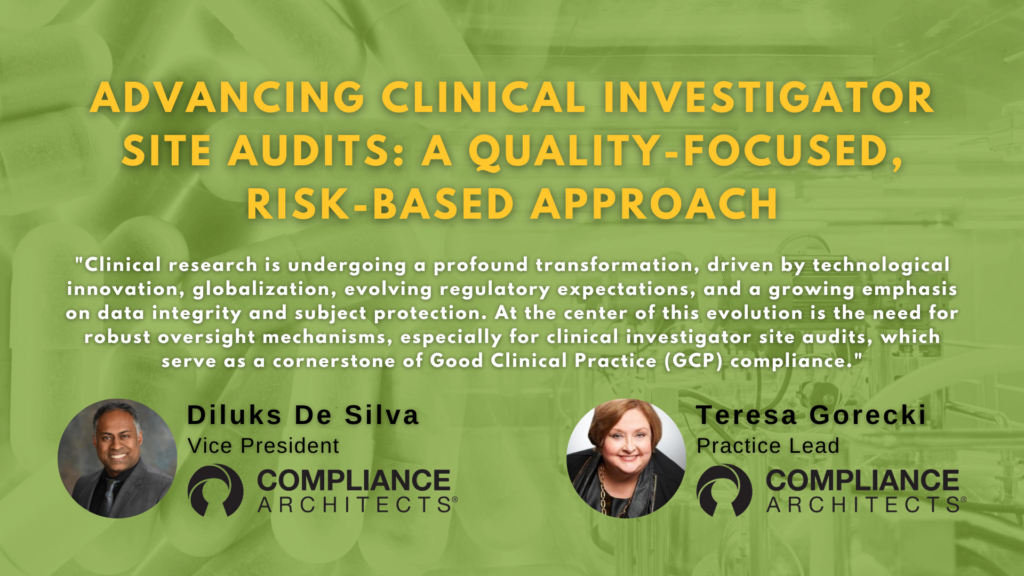The following transcript is taken from a Business Intelligence Solutions Interview that talks about FDA Inspection Readiness.

What are the most significant issues currently facing FDA-regulated companies when it comes to FDA inspections?
FDA-regulated companies are currently dealing with a multitude of challenges. Initially, companies have been aware of the reduction in FDA enforcement rigor that has occurred over the last 8 to 10 years, and many companies have, as a result, let their guard down regarding FDA inspection readiness.
Additionally, due to significant economic challenges, companies have had to do more with less. Since companies had been observing that their overall enforcement risk had been reduced, there was no real incentive to ensure robust quality and compliance programs. As a result, quality and compliance staffing has often been either frozen or reduced.
I’m aware of one leading pharmaceutical/medical device manufacturing company that eliminated a significant portion of its corporate quality and compliance oversight function a few years ago, and, not surprisingly, is now experiencing problems within the organization.
Unfortunately, when times are tough, executives often scrutinize the cost of these functions and overlook the importance of quality and compliance roles in ensuring companies aren’t devastated by adverse legal/regulatory enforcement actions.
As a result of the new FDA Commissioner, Margaret Hamburg, are you seeing an increase in the intensity and frequency of inspections?

FDA has, as most people know, been slowly increasing the quantity, intensity, and overall rigor of its inspection activities with respect to FDA-regulated companies. In August of last year, FDA commissioner Hamburg outlined in the first Commissioner’s speech to deal exclusively with enforcement, the FDA’s new approach to aggressive enforcement activities, and their desire to “streamline” the enforcement process.
So far, it appears that enforcement activity is increasing at a slow and steady pace. The Obama administration likely has so many issues on its plate that FDA enforcement and product safety have not yet received the attention that they would have under normal circumstances. I would expect that eventually, significant attention will be placed on supply chain security and product safety, and inspection and enforcement action will increase substantially.
What are the areas and issues that are creating the most risk for companies in the current environment?
There are many issues currently of concern for FDA-regulated companies, which create real risks. Initially, despite years of familiarity with FDA regulations and expectations, many companies have not fully implemented robust quality and compliance systems. I find that many companies don’t know what they don’t know.
They are under the assumption that their systems are fine, and that things are “in control”, when nothing could be further from the truth. These companies are the ones at most risk from the increasing level of FDA enforcement. Even if the FDA does not increase the level of intensity and quantity of inspections, it is already far less cooperative with companies that “don’t get it” and/or that have a history and track record of substandard compliance activities.
For companies that have generally embraced proper approaches to compliance and quality management over the years, the traditional areas of concern will continue to be areas of intense scrutiny by the FDA. Perennial favorite CAPA can most assuredly be considered one of the most essential quality subsystems to have fully prepared (and objectively assessed) before getting a review during an FDA inspection. The FDA’s focus on external supply chain security and offshore and outsourced operations places companies that perform much of their operations through third parties at an increased risk.
These companies must have a robust oversight program in place to ensure that they are fully aware of the actions of their third-party provider and that all requirements and responsibilities (including controlled change and investigations) of the provider are being executed. Finally, companies can expect the FDA to review their process/product knowledge (or characterization) and how this knowledge is being used to drive proper CAPA investigations, recall decisions, change management, validation, and the design of their process control frameworks.
In light of the foregoing, what would you recommend companies do to prepare for their next FDA inspection?

Since companies within the US are subject to FDA inspections without notice (even though they generally follow a rough anticipated schedule), they need to be what I call “ever ready” for an FDA inspection. This state of readiness ensures that a company can quickly mobilize when an FDA Investigator walks through the door and readily provide access to, and explain, their systems, procedures, practices, products, and quality records that the FDA will be looking for.
Also, this state of readiness should be reinforced by company executive management through periodic walkthroughs with knowledgeable individuals. The benefit of this is that, with a little effort, it can demonstrate that the executive team is committed to a high state of readiness and the importance of achieving excellent inspection outcomes.
Companies outside the US are somewhat more fortunate, as they receive prior notice of an FDA inspection. However, these companies shouldn’t become too complacent. There is often far too much work and change to get done within the typical month between notice and inspection to prevent significant inspection observations truly.
As part of an “ever-ready” approach to FDA inspection readiness, companies should have a number of things “in place” at all times (at a minimum) ready to review with an Investigator when they walk in the door. These include:
- A copy of their inspection procedure(s);
- A binder of their Quality Manual (or equivalent) and an index of their Policies, SOPs, Work Instructions, Guidances, Standards, and/or other documents that comprise their quality system documentation;
- An “introductory presentation” about the company, its products, the site, the manufacturing areas, the leadership team, and the processes the Investigator will be looking at;
- A binder of at least five complete years of regulatory inspection documentations, including 483s (if any), EIRs, Warning Letters (if any), full responses to 483s and Warning Letters, and a complete index of commitments and documentation of commitment completion.
There are many additional steps a company can take to prepare for the inevitable inspection, including conducting CAPA record reviews, developing process control plans, and creating advocacy-based messaging to substantiate quality system decision-making. As the saying goes, “in time of peace, prepare for war,” and nothing could be more relevant today for FDA-regulated companies.
Contact Us
For further information on FDA Inspection Readiness, contact us using the form below.





